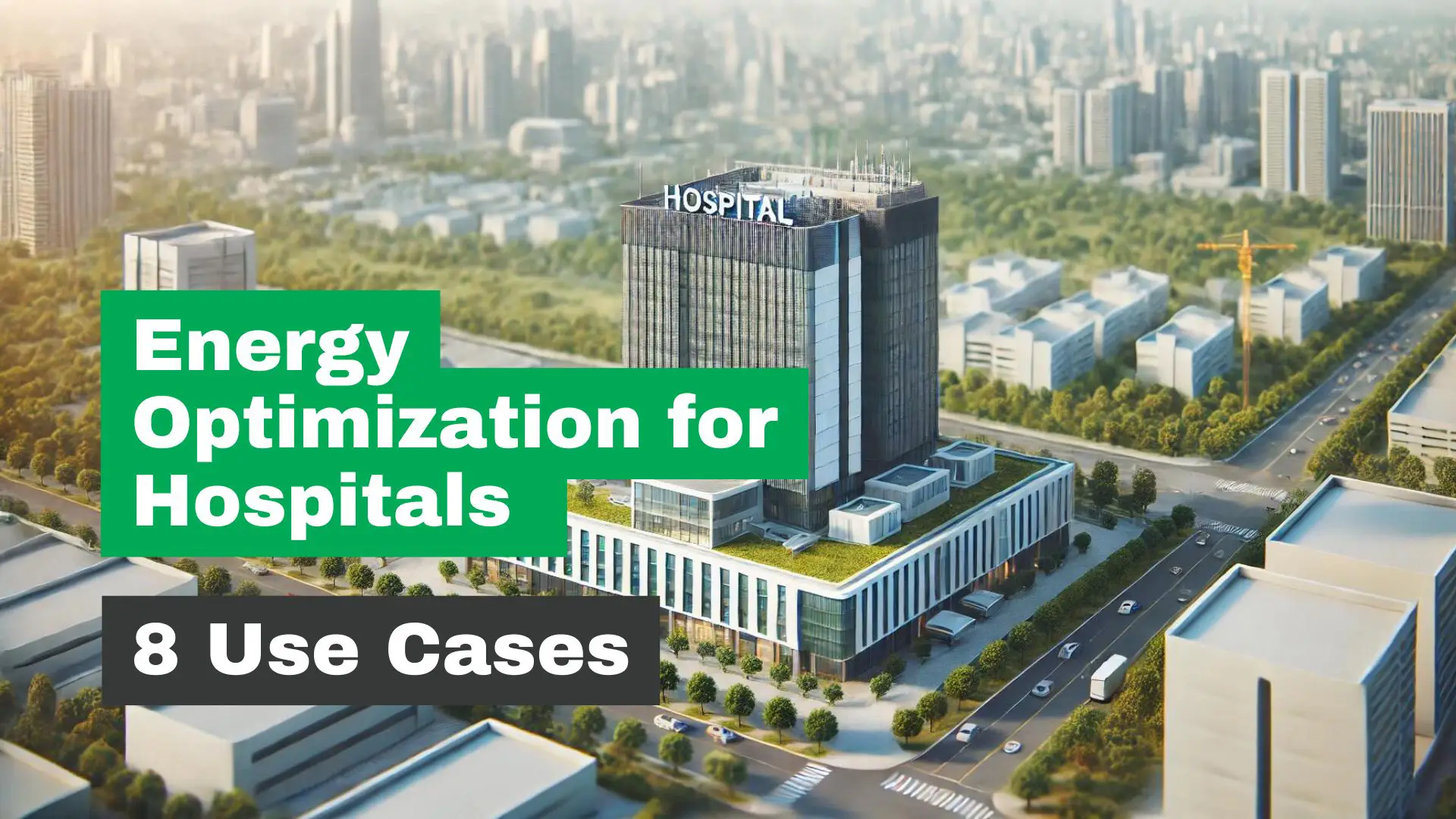Rising energy costs present a substantial challenge for hospitals, making energy optimization for hospitals a critical focus. With continuous energy demands, sophisticated medical devices, and the need for consistent environmental regulation, hospitals must enhance sustainability and energy efficiency.
Hospitals can enhance sustainability and energy efficiency by establishing LEED, WELL, Energy Star, GGHC, and ISO standards to address these challenges. These certifications are crucial in improving operational efficiency, reducing environmental impact, and promoting patient well-being.
Integration of advanced HVAC systems, automated lighting, intelligent cleaning solutions, and comprehensive building management systems can enable smart hospitals to achieve considerable energy savings while upholding a secure and comfortable environment.
To fully understand the potential of these technologies, let’s delve into 8 specific use cases that demonstrate how hospitals can effectively implement IoT and smart solutions to drive energy optimization and operational efficiency.
Use Cases for Energy Optimization
1. Energy Optimization for Hospitals Using IoT-Enabled HVAC System
IoT-integrated HVAC solutions are revolutionizing how hospitals manage their heating, ventilation, and air conditioning systems. These smart systems allow for real-time monitoring, enabling facility managers to track performance and energy use continuously.
Benefits:
- Real-time Monitoring: Facility managers can monitor HVAC performance and energy use in real-time.
- Predictive Maintenance: IoT sensors can detect potential issues before they become major problems, reducing downtime and maintenance costs.
- Optimized Energy Consumption: Ensures HVAC systems operate efficiently, providing a comfortable environment for patients and staff while minimizing energy waste.
Practical Example: Hospitals that implement IoT-enabled HVAC systems could potentially reduce energy costs by up to 20% within the first year.
2. Energy Optimization in Hospitals Through Automated Lighting Systems
Smart lighting systems equipped with IoT and automated controls are transforming hospital lighting management. These systems offer substantial energy savings by adjusting lighting based on occupancy and natural daylight.
Benefits:
- Energy Savings: Adjusts lighting based on occupancy and daylight.
- Adaptive Lighting: Creates optimal lighting conditions that improve patient comfort and staff productivity.
- Automated Schedules: Motion sensors and automated schedules significantly reduce energy consumption and costs.
Practical Example: By installing automated lighting, hospitals might achieve a 30% reduction in lighting energy use.
3. AI-Driven IoT-Based Building Management Systems (BMS)
Implementing an AI-driven BMS allows for comprehensive analysis of data from various building systems such as AHUs, VAVs, Chillers, Boilers, FCUs, thermostats, and sensors. This smart building software identifies inefficiencies and provides actionable insights for optimization.
Benefits:
- Centralized Control: Integrates smart technologies with AI to enhance management efficiency.
- Intelligent Energy Monitoring: Uses AI to track, analyze, and optimize energy usage patterns.
- Proactive Resource Management: AI-driven adjustments reduce costs and improve operational efficiency.
Practical Example: AI-based BMS analysis can optimize system performance, leading to potential energy savings of up to 20%.
4. Curtain Control Automation
Curtain control automation in hospitals using IoT controllers allows for the efficient management of natural light and energy usage. These controllers adjust curtains based on real-time data from IoT sensors, such as light levels, occupancy, and time of day.
Benefits:
- Energy Efficiency: Minimizes the need for artificial lighting by maximizing natural light usage through automated curtain adjustments.
- Enhanced Comfort: Provides personalized control over light levels in patient rooms, improving comfort and privacy.
- Independent Operation: Utilizes IoT controllers for seamless integration without requiring any human intervention.
Practical Example: Automating curtain control via IoT can reduce lighting energy consumption by up to 10%, enhancing both energy efficiency and patient satisfaction.
5. Smart Energy Recovery Ventilation (ERV) Systems
Energy Recovery Ventilation (ERV) systems with IoT integration are essential for maintaining indoor air quality while optimizing energy use. These systems recover energy from exhaust air, using it to precondition incoming fresh air, thereby reducing the load on HVAC systems.
Benefits:
- Energy Recovery: Recovers energy from exhaust air.
- Enhanced HVAC Efficiency: Reduces the load on HVAC systems.
- Real-time Data: Provides real-time data for better management.
Practical Example: Hospitals implementing ERV systems with IoT integration could improve HVAC efficiency by approximately 18%.
6. Integration of Renewable Energy Sources with Smart Grids
Integrating renewable energy sources such as solar panels with smart grids is a powerful way for hospitals to achieve sustainability goals. Smart grids manage the distribution of renewable energy, ensuring efficient use and load balancing.
Benefits:
- Sustainability Goals: Helps hospitals meet sustainability targets.
- Energy Cost Reduction: Lowers reliance on traditional energy sources.
- Automated Energy Management: Ensures efficient use and load balancing.
Practical Example: Hospitals integrating solar panels with smart grids might reduce their energy costs by around 35%.
7. Real-Time Energy Monitoring and Power Quality Analytics
Implementing real-time energy monitoring and analysis for low and mid-level voltage systems, along with real-time power quality analytics, is crucial for maintaining hospital efficiency. This approach continuously tracks energy usage and power quality, allowing facility managers to respond immediately to inefficiencies and issues.
Benefits:
- Identify Inefficiencies: Real-time data reveals areas of energy waste and power quality issues.
- Immediate Improvements: Enables prompt adjustments for optimal energy use.
- Enhanced Energy Efficiency: Ensures consistent operation at peak efficiency.
Practical Example: Real-time energy monitoring and power quality analytics can lead to up to a 20% reduction in energy consumption and improved system reliability.
8. Smart Cleaning and Maintenance Systems
Integrating IoT with cleaning and maintenance operations transforms these essential services into efficient, automated processes. Smart cleaning systems use IoT sensors to schedule and optimize cleaning routines, ensuring that resources are used effectively.
Benefits:
- Optimized Cleaning Routines: Ensures effective use of resources.
- Improved Hygiene Standards: Maintains high hygiene standards.
- Reduced Energy and Water Consumption: Automated systems reduce waste.
Practical Example: Implementing smart cleaning systems could reduce water and energy usage by up to 22%.
Future of Smart Hospitals
The integration of IoT and smart technologies in hospital infrastructure is not just a trend but a necessity in today’s energy-conscious world. These solutions provide a pathway to significant energy savings, reduced operational costs, and enhanced patient care. By adopting advanced HVAC systems, automated lighting, smart cleaning solutions, and comprehensive building management systems, hospitals can achieve:
- Significant Cost Reductions: Lower energy bills and maintenance costs lead to considerable financial savings.
- Enhanced Patient Comfort: Optimized climate control and lighting improve the patient experience, contributing to better health outcomes.
- Improved Operational Efficiency: Real-time monitoring and predictive maintenance reduce downtime and ensure that hospital operations run smoothly.
- Sustainability Goals: Reducing energy consumption and integrating renewable energy sources help hospitals meet their sustainability targets and reduce their carbon footprint.
- Regulatory Compliance: Smart technologies aid in meeting increasingly stringent energy efficiency regulations.
As hospitals continue to adopt and implement these advanced systems, they will be better equipped to meet the challenges of rising energy costs and stringent regulatory requirements. The future of healthcare lies in smart, energy-efficient solutions that not only save money but also enhance the quality of care.




